
Бесплатный фрагмент - Modern table tennis: strokes, trainings, strategies
A word from authors
Hello, dear reader! If you keep this book in your hands, then you are interested in table tennis, and especially you are interested in its modern state. In this book, we’ll talk about the development trends of this fascinating Olympic sport.
We promise that the journey to modern table tennis will be interesting for you, and most importantly, useful. We are sure that you will learn a lot from the pages of the book, in which we consider the basic strokes paradigm shift: the forehand topspin (loop), the backhand topspin and the serves. We will tell about different variations of strokes in detailed illustrations. You will become more aware of how to strike in a particular situation. Drawings are simple and understandable and you can easily repeat it at home. Let’s go deep into the psychological training of athletes in table tennis and touch on powerful and effective approaches that will be useful for a coach and an athlete.
We tried to put our coaching experience into this book, as well as our research and knowledge of table tennis. We encourage you to share the information you liked about this book with your friends-athletes, so you will further strengthen the new knowledge that will eventually evaluate into playing skills. Whether you are a recreational athlete, a professional or a table tennis coach, in this book everyone will find something for themselves.
Artyom Utochkin
Vasilii Zhdanov
Ivan Zhdanov
Chapter 1. Modern table tennis
Table tennis is constantly and actively developing. New approaches and methods are introduced into the training process; the style of the game today is very different from the style of ten or twenty years ago. Table tennis is becoming a gloving and high-speed sport: the main purpose of the rally is to seize the initiative. There are players with versatile styles as opposed to one-sided style directions. Masters begin to add ball’s maximum spin, as well as speed; and ball possession stability and the ball accuracy increases every year. Attaking actions are carried out both from the near and the middle zones, while the zones change occurs without loss of initiative. The strokes are becoming more sharp and unexpected, as well as with constant sidespin. The psychoemotional preparation and stability in the matches comes to the fore. It is about these new trends we are going to talk in our book.
The prehistory of the forehand topspin, or how we came to a modern version of the stroke. History of the paradigm shift
Before discussing the forehand topspin technique and features of its tactical use, let’s take a look at the history of table tennis and see how the forehand topspin was born and transformed before it obtained a modern look that you can see at major tournaments or browsing matches of any of the strongest athletes of the world on YouTube.
In the 20—30’s of the last century, the rackets that were used to play table tennis were differed from the modern ones, just as the computers of the 70’s differ from today’s personal laptops.
And if the shape of the racket has not undergone global changes, its playing characteristics have changed dramatically. At that time, pipped rubber was attached to the wooden blade, which provided more control and variability than the use of a simple bare blade without rubber.
Due to the pips, it was possible to chop the ball more gently and hit without spin. They nevertheless added some rotation to the ball and, therefore, it was much easier to strike, than striking with the blade without rubber.
The revolution occurred in the late 40’s, when the athletes began to use the “sandwich” rubber, that is, rubber sponge was glued under pips. Thus, the rubber began to consist of two layers, that is why it was called “sandwich” rubber.
We can say that this was already a prototype of the modern rubber sheet. Pips together with a sponge gave much more control, variability and ball spin. Table tennis made a step forward.
The next and most global step in the table tennis development was one of the world championships in the late 50’s, when the Japanese tennis players brought an absolute innovation — a “sandwich” rubber, consisting of a sponge and a smooth rubber surface. It was already an almost modern version of the rubber sheet (today, only the rubber characteristics are better — the essence remains the same). But the most important thing is what the Japanese athletes began to perform due to these rubber sheets.
We hope you have already guessed that they brought a heretofore unknown element to the world championship — that is the topspin (loop). By the way, Soviet athletes, visiting the world championship in 1961, called this element “the devil’s ball from Tokyo.”
Japanese athletes of that time used exclusively Asian racket grip, called “pen”. Such grip, in its classic performance, can be fully performed only at the forehand topspin, which was successfully applied by Japanese athletes at that and several of the next world championships; and they became undisputed favorites on these championships, winning 4 to 6 gold medals out of 7 sets of medals.
In the 1960’s, the forehand topspin technique was developing, largely due to the Japanese tennis players. The forehand topspin became a more high-speed element, and table tennis began to become more athletic due to the more physically trained players who performed the forehand topspin more powerfully and quickly.
In the 1970’s, Hungarian tennis players were among the leaders of the world table tennis. They began to use the possibility of overlap type “sandwich” to the maximum extent and modified technique of top-spin on the right.
They began to move a long distance from the table and, performed a loop drive (both forehand and backhand) with a very high trajectory up, lowering the ball almost to the floor.
At first, it seemed that the Hungarian athletes pushed the topspin development in table tennis a step back, because at that time there was a number of Japanese athletes who were approaching performing the topspin at the highest point of the ball’s rebound.
But, after reflecting on this, one can come to the conclusion that Hungarian athletes have shown a different topspin facet: the maximum spin. They were able to make maximum use of “sandwich” rubber with a smooth surface.
In the late 70’s and early 80’s, Chinese athletes took away the crown of table tennis, that before that was wandering between athletes from Sweden, Hungary and Japan.
How did they do that?
The Chinese found a weighty counter-argument against topspin with the maximum possible rotation. They began to play with the pips in the immediate vicinity of the table, focusing on the speed and game acuity, giving no time and opportunity for European athletes (many of whom tried to play in the Hungarian style) to perform serial top-spin from the middle and far zones, who added strong rotation to the ball.
It was the fight of styles that led to a new paradigm of performing the forehand topspin, which was designated by young Swedish tennis players. They changed the forehand topspin technique by making the movement shorter and more rational. Due to this technique, the ball reached almost the same rotation as at the topspin from the far zone, but the ball speed increased dramatically.
This became possible due to the fact that the new generation of Swedish tennis players (Jan-Ove Waldner, Jörgen Persson, Mikael Appelgren, Erik Lindh) began to perform topspin much closer to the table and at the highest point of the ball rebound.

European athletes were leading again, and they were the ones who dominated on the international arena in the late 80’s — early 90’s.
At this time, Chinese athletes were preparing a new generation of players who started using the same forehand topspin principles, that the Swedish athletes had so far-sightedly applied. It’s worth mentioning that since that time forehand top-spin technique didn’t undergo any global changes.
The same principles that were used by young Swedish masters, are used in the modern table tennis nowadays.
This chronology of stroke evolution, in our opinion, is very important to understand how the world of table tennis came to the modern forehand topspin, which is now the most important, integral part of the technical arsenal of any self-respecting tennis player.
The role of the backhand top-spin in modern table tennis. History of the paradigm shift
Ball possession with the left topspin performed by today’s table tennis stars is fascinating. In modern table tennis, we see that the backhand top-spin is executed at high speed. Masters of a small ball skillfully use it in close proximity to the table and in the middle zone. Nevertheless, the role of the backhand top-spin and its purpose in modern table tennis is not the same as it was 15—20 years ago.
In order to assess its role, we need to look into history and understand how the backhand top-spin developed, what has changed and how it came to today’s version. The backhand topspin (loop) began to develop later than the forehand loop.
If the Japanese athletes began to apply the forehand topspin at the very end of the 50’s, then the backhand topspin appeared in the European school in the second half of the 60’s.
The greatest wizards of the backhand topspin were Hungarian and Yugoslav athletes. Such masters as Gábor Gergely, Istvan Joner, Dragutin Shurbek and others.
In the 70—80’s, the backhand topspin was used on an equal ground with the forehand topspin and was executed from the same distance. At that time, players always had some dominant side: someone had a more powerful forehand topspin, and someone performed more powerful backhand topspin. A vivid example of an athlete with a dominant and more powerful left side is our great Soviet athlete Andrei Mazunov.
The paradigm of using the left stroke (not speaking about top-spin, but the game itself) gradually began to change in the second half of the 1980’s. The pioneers were leading Swedish athletes (Jan-Ove Waldner, Jörgen Persson, Mikael Appelgren).
In the late 70’s and early 80’s, as you remember from the first part of the story about the forehand loop (topspin), Chinese athletes performed a very active game near the table using attacking pimples.
European athletes who used top-spin from the middle and far zones began to lose to the Chinese, not having any chance against them in speed.
A new generation of Swedish tennis players used the following antidote: they approached the table and began to perform top-spin at the highest point of the ball rebound. It was difficult for the Chinese tennis players to cope with such an attack and gradually they also switched to another game model using a topspin with a smooth rubber.
The fact that Swedish athletes began to play closer to the table also influenced the tactics of the game on the left side. They began to play much closer to the table on the left side.
If the forehand topspin, having undergone a number of changes in technique, was used by tennis players constantly, at every opportunity, then the backhand loop developed less rapidly.
In the mid 80’s a new generation of European athletes led by Swedish masters played performed the backhand loop in only half of the opportunities. Very often, an active counter-play was performed on the left side of the table.
Backhand loop technique, due to which one could perform the backhand top-spin close to the table, was not yet determined by that time. Anyway, the full execution of the backhand topspin forced the athlete to move slightly to the middle zone. In such a situation, hand counterdrive near the table often was much more effective, supporting the attack speed and allowed to stay closer to the table when playing on the left side and not moving to the middle zone.
The vivid examples of such game model were Jan-Ove Waldner and Ma Wenge. Both these athletes were in the top five at that time, and most often in the top three of the world’s best athletes.

If we look at today’s table tennis, we can see the following picture: the leading athletes perform the backhand topspin near the table, with a rather short hand movement, without trying to win the point by this move.
The idea of today’s backhand loop is not to lose the game on the left diagonal, and to create an opportunity to perform the more powerful forehand loop.
If we look back once again, we will notice that players like Jan-Ove Waldner and Ma Wenge used the prototype of today’s game model. The idea was the same — they used the left-side game in order to keep the opponent on the tenterhooks at high speed and prepare a platform for a more powerful forehand loop. The only difference from the modern game model is that the hard left-side counter-play near the table was replaced by the backhand topspin, which is also performed near the table but is more variable and difficult for the opponent and more reliable for the one who performs it.
The first sportsman who suggested such game model: the backhand topspin in the near zone + the powerful forehand top-spin — was the Chinese athlete Kohn Linghu.
He is rightfully considered the “father” of today’s table tennis developing trend.
The way he came up with this idea remains a mystery. It is possible that it wasn’t his idea, but, for example, his coach, but that is just the point that Kohn Linghu was the first to perform the model of table tennis that we see now in the game of leading Asian and European masters.
By the way, Kohn Linghu became the world champion in 1995 and the 2000 Olympic champion. During these 5 years he took first place in the world ranking very often. As you can see, it was not that simple.
To date, the backhand topspin technique close to the table, performed by such masters as Ma Long, Czhan Chzhike, Fan Zhendong has reached great heights. They began to play even sharper, more diverse, but still the paradigm of the game offered by Kohn Linghu remains unchanged.
History of service changing in table tennis
With a good tradition, formed in the last chapters, let’s take a look at the history. At the dawn of the table tennis on international arena serving really was just putting the ball into the game. This was due to the general rudimentary level of table tennis development in that period, both in terms of the game, and in terms of the equipment used.
With the progress in the blade and rubber production for table tennis, all the elements became more complicated. Serves weren’t left behind. In the late 50’s and early 60’s, Japanese and Chinese tennis players began to make heavy services with a spin.
Further, the level of services grew, more and more tennis players began to use service with the spin. Serve was no longer just the introduction of the ball into the game, but a formidable weapon in the hands of good masters.
In the 70’s, the serving complexity began to increase due to the imperfection of table tennis rules. At that time, the height of the ball throwing was not indicated (now it is 16 cm) and many tennis players began to serve “from hand”.
If you play table tennis for at least a year or two, you perfectly understand how difficult the service can be if you do not throw the ball, but throw it right away on the racket. Hand service can be compared with a goal from offside, when the rules do not prohibit it the chaos begins in the game.
A number of top-level tennis players went even further. They did not just serve the ball from the hand, but they also added an extra spin due to the fingers of the hand that threw the ball. As a result, the atomic mixture was obtained, and it was very difficult to cope with the service.
The peak of such service development was reached by the end of the 70’s, after which the International Table Tennis Federation (ITTF) changed the rules, adjusting the service rules.
Now it was necessary to throw the ball no less than 16 cm high and perform at an angle of at least 45 degrees — it is compliance with this angle does not allow to throw the ball immediately on the racket, giving it an additional impulse in the form of acceleration or spin. Also, it was set up in the rules that since now athletes can throw the ball only with an open palm. If the ball is thrown by the fingers, then a point was taken from the player.
The introduction of these rules ended the era of services, the complexity of which was created due to the lack of clear rules. And although the transition was gradual, still many continued to serve, not strongly adhering to the rules, and a number of umpires weren’t too strict and closed their eyes to those moments: with the change of generations, these serves have gone down in history.
Since the mid 80’s, services began to develop in a different direction. They became more difficult, but now the athletes were looking for complexity in other aspects.
At present, the main three components of a service are: the ball processing technique, which has been constantly improved, the position in front of the table and the ability to cover the moment of touching the ball and racket with the left hand and core.
Now the athletes began to use the forehand service more often. At the same time, they approached the table with their left side to hide the moment of touching the ball and racket.
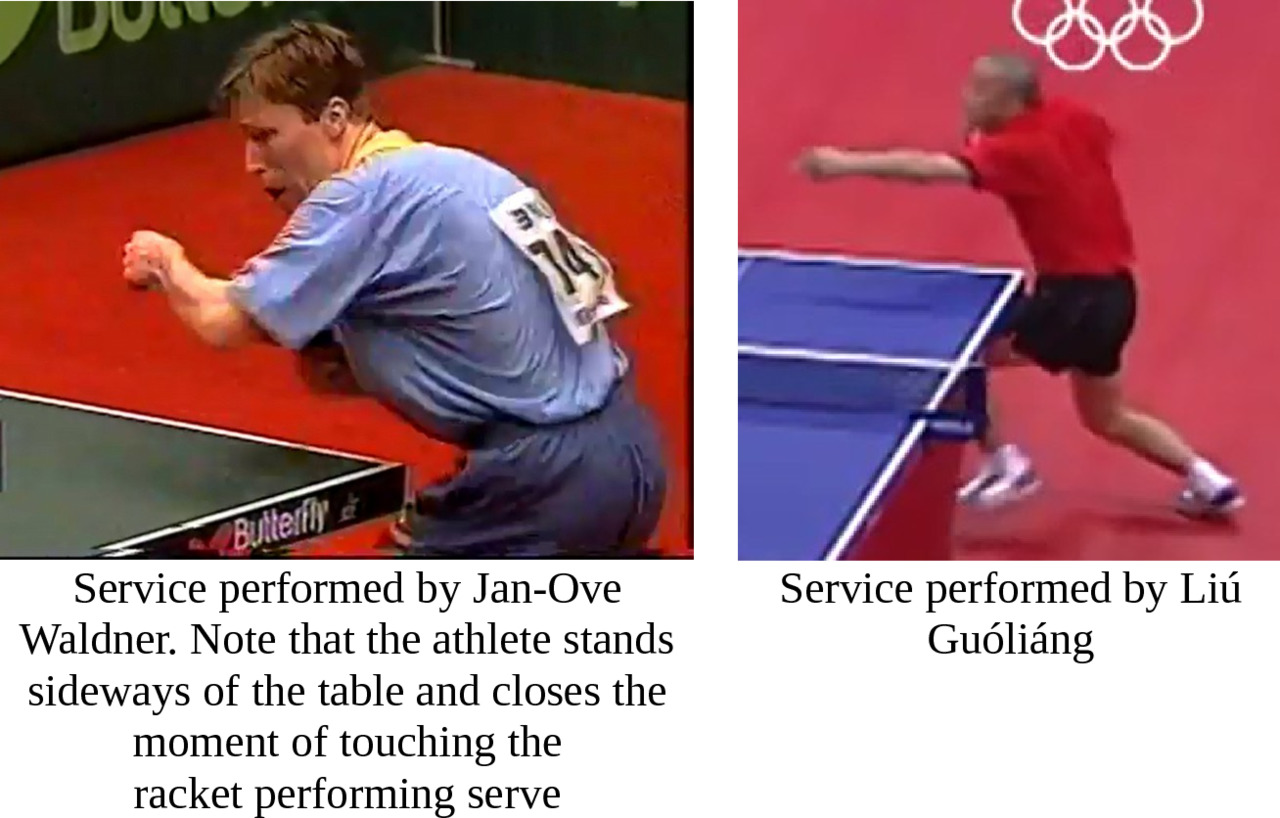
The peak of complexity development of services performed in this way was reached in the mid-90’s. Outstanding masters of that time were Jan-Ove Waldner and today’s coach of the China men’s national team Liu Guoliang.
Those who play table tennis for a long time, remember that at that time the set was played up to 21 points and with 5 services.
In those years service complexity reached such a level that a series of five services became an analogy to the home serve game in tennis. If one lost his series of serves
2:3, and then the opponent converted his series 4:1 then you already lose 7:3. Another unsuccessful series of home serves and chances to win the set are miserable.
The services were so complex that in a series of 5 services there could be 2 errors immediately on return and 2 more passive returns that allowed the server to win the next point in the same manner.
The International Table Tennis Federation believes that complex services to some extent limit the possibility of a long rally and this affects the spectacularity of the sport.
Beginning from the late 90’s, the topic of a new round of changes in the service rules was actively discussed. As a result, in 2002, the new rules forbade hiding from the opponent the moment of touching the ball and racket with a hand or body.
As a result, at the beginning complexity of the services fell dramatically, but it lasted a year; and then with the full connivance of the umpires, the athletes began to cover the ball with the core, hiding the moment of touch of racket and ball.
Thus, the International Federation did not succeed, in weakening the influence of the service on the rally. Serves at a high level remained very complex.
And at the moment when these lines are being written, a new storm of discussion has begun in the world concerning the weakening the influence of the serve on the rally. One of the options that is now actively discussed is the complete transition to the backhand serve. If this happens, then it will be a very dramatic change.
Principles of organizing and training athletes in China — the world leader in table tennis
Currently, Chinese athletes show excellent results and are the vivid leaders in this sport. It is the Chinese athletes who are now setting the main directions for the development of table tennis. Table tennis is one of the mass and successful sports in China that has maintained world leadership for more than 50 years.
What are the reasons of the phenomenal success of Chinese athletes at all major tournaments? Having answered this question, one can understand modern trends of table tennis development.
Support of table tennis by state leaders. Several generations of political leaders of China have supported table tennis as a national sport. So, Deng Xiaoping constantly kept tab on the success of the adult national team, as well as paying attention at the youth. In 1990 Jiang Zemin even sang a hymn to table tennis and not only regularly attending competitions, but also team trainings. In 1995, he participated in the opening ceremony of the World Cup in China, to meet the leaders of the Committee of International Table Tennis Federation.
The national development strategy. “Training at home and competing with foreigners” is the main strategy of table tennis development in China. The regional teams support the national team, and national table tennis team oversees the sports schools, student and school teams. The national strategy of the table tennis development respect and support between the upper and lower layers of the sports institutions is mutual.
The scientific approach in training. Coaches use mathematical models in the training process, which simulates main rivals way of playing. In addition, a detailed video analysis, simulation analysis and knowledge about the opponent are implemented. All this adds confidence to athletes in a future game. Through the simulation, they are completely prepared psychologically, not only technically.
Creating competition inside the team. Two national teams are formed in China: the first and the second. On the one hand, of the first team players feel pressure, on the other hand, it motivates second team players to get into the first team. Thus, levels of both teams are growing through mutual competition.
Closed trainings before major tournaments. Wide training camps and closed training process before important matches are one of the vital approaches of the Chinese team. The purpose of camps is that athletes would be fully prepared physically, technically, tactically and psychologically.
Training plan. Chinese coaches put emphasis on “what to train?”, “how to train?” and “how much to train?”. The establishment and implementation of the training plan is the basic need for every athlete and coach. Training plan is the basis of the training system. The content of training schedule of a given sportsman is decided by a team of researchers and coaches.
Summation after responsible and important games. Regardless of the achievements of the national team, Chinese experts collect all materials into a large report for analysis and summation.
Having examined the basic organizational scheme of the Chinese national team let’s move to the main principles used in the preparation of Chinese athletes.
Recapturing initiative in the game
The fundamental premise of athlete’s tactical action sounds like this: “creating moments to recapture the initiative”. What does this mean? When making strikes one should impose a defensive style of game to his opponent, performing hard strokes to inconvenient spots. The initiative should be seized at each stage of the game process, starting from service and ending with the block. While in defense, you should look for an opportunity to weaken the opponent’s pressure and make counterdrives, “taking game control by the throat”.
Developing the strengths
Coach must identify the strengths of the athlete and build the training on the basis of his strengths development and its variation. When strengths become second nature, it allows one to be all over the game. That’s how a unique style of player emerges.
Mastering weaknesses
Constant mastering of the athlete weaknesses during the training process. The modern player should have versatility and ability to play in different situations. Obvious weaknesses are identified by the opponent, who puts his efforts into focusing on them.
Constant competition
Learning the necessity to constantly seek the opportunity to attack and possess the initiative in the rally. Attacking, aggressive style of play and the constant competition — is one of the critical success factors in today’s tennis.
The balance between defense and attack
The player should be mature both in attacking and defensive style — this will create additional space for maneuverability and variety during the game. The opponent must never predict how one returns the ball.
The aggressiveness, speed, spin and unpredictability
The aggressiveness throughout the game and a desire to take the game control over. The ever-increasing speed along with the spin. Only their combination will lead to success. The unpredictability of the game in order to not let the opponent unlock your game strategy, so he would always be under pressure and constrained in his actions.
Chapter 2. Basic strokes of modern table tennis
Let’s start with the most important stroke in table tennis — topspin/loop. Top-spin (top-spin) is translated from the English language as the top rotation (spin). In fact, any ball that has a top-spin in table tennis logically should fall within the definition, but it is actually more complicated.
When we say “top-spin”, we mean a powerful attacking element, which provides maximum top rotation and the speed of the ball.
Top-spin is a table tennis game element that is the most acute and difficult to return.
All players with senior adult degree and higher are capable of forehand top-spin, but in the hands of the masters among first one hundred strongest athletes in the world it is a powerful weapon, which they seek to apply in every rally (of course, in except the players, advocating a protective style) and win a point due to this element.
We’re going to devote this chapter to the forehand topspin — the most powerful and commonly used element in modern table tennis.
Different variations of the forehand top-spin
Forehand top-spin, as already mentioned, is an integral part of the technical arsenal in modern table tennis. Athletes playing in an attacking style (more than 90%) who perform 60—70% of attacks use exactly forehand top-spin. The number of points won due to forehand top-spin, in total, exceed 50% in the most matches.
The number of variations of the forehand topspin is outplayed, perhaps, only by the number of table tennis serve variations. However, if we consider only gaming elements,
the forehand top-spin is the most hygienic stroke.
To show you the importance of the forehand top-spin as an element, let’s imagine the following situation: imagine that an athlete can’t perform forehand top-spin at all, but he masters all other tennis elements. What are the chances of such athlete? Perhaps his chances, in this case, tend to zero.
Now, for example, let’s “take away” the backhand top-spin from our imagined character. Will there be any chance to succeed for such an athlete? Definitely! Do not believe? Remember who became the Olympic champion in 2004. Right, Rue Seun Min. The representative of classical penhold with the ability to perform only a forehand top-spin.
The point is, that even without having a backhand top-spin in the arsenal, one can become an Olympic champion.
The same is with any other game element (serve is not a gaming element). The absence of any element can be compensated. But the absence of the forehand topspin cannot be compensated. All this stresses the crucial importance of this stroke in today’s table tennis.
Now let’s talk about the variability of the forehand topspin. Stroke technique is unusual due to the fact it has a lot of variations. And this is the last choice. Depending on a height, speed, rotation of a received ball, the top-spin technique is being changed. And that’s when the forehand top-spin technique changes are most significant than in other elements. Often, even different principles are used, but more on this later. For now, it’s enough to remember that forehand top-spin has many variations that differ significantly from each other in the T. Committee manner.
Let’s open a small secret. Most table tennis players make a lot of mistakes when performing forehand topspin on the right because they do not understand that each variation of the forehand topspin requires a separate insight and technical workover.
Conditionally, we can distinguish 10 variations of the forehand topspin shot; whereas, it can be divided into some subvariations. It is worth noting that it’s not widespread. So, let’s now briefly consider the following: What stroke variations exist and in what situations are they used?
Variation #1. Forehand top-spin against a simple ball or block
This is a classic top-spin, the basic version of which is being mastered at the earliest stages of learning table tennis techniques. We can say that everything starts with this variation. Not mastering it sufficiently, you will not be able to master the other. Not even worth trying. It’s like learning to run if you didn’t learn how to walk. Everything is good in its season
Forehand top-spin is performed against the block during the open rally in table tennis when one athlete attacks and the other is forced to defend himself, returning the ball to the table with a block or, as it is also said in table tennis, “drive”.
There’s another branch of this variation: Forehand topspin against the block, that is performed in return to the chop.
Let us explain. Imagine that during a match you performed a serve with a lower spin and received a chop with a top-spin. Your opponent received the ball, and you’re doing a second top-spin. But what’s the difference, because a top-spin against the block is a top-spin against the block? But there is a difference.
The fact of the matter is that when you make a top-spin with a chop, your opponent receives it with a block, a spin from your top-spin remains. And this rotation requires a slightly different handling than with a drive against the block.
We’ll open a secret that you can significantly raise your game level. The fact is that the number of errors, committed by athletes in the game with the second forehand loop is considerably higher than in the third and subsequent top-spins.
This nuance is usually under the radar. And many athletes don’t even realize why they are quite often mistaken exactly in the second step.
Those who begin to take this nuance into account, immediately increase the stability of the second top-spin and, as a result, its overall level.
Perhaps you have a question: “Is this nuance can be seen when viewing the games featuring table tennis stars?”. A reasonable question and the answer is this. It seems there’s no visual difference between top-spin against the simple block and chopped top-spin against a block. The difference is in the first touch. And the first touch does not usually stand out.
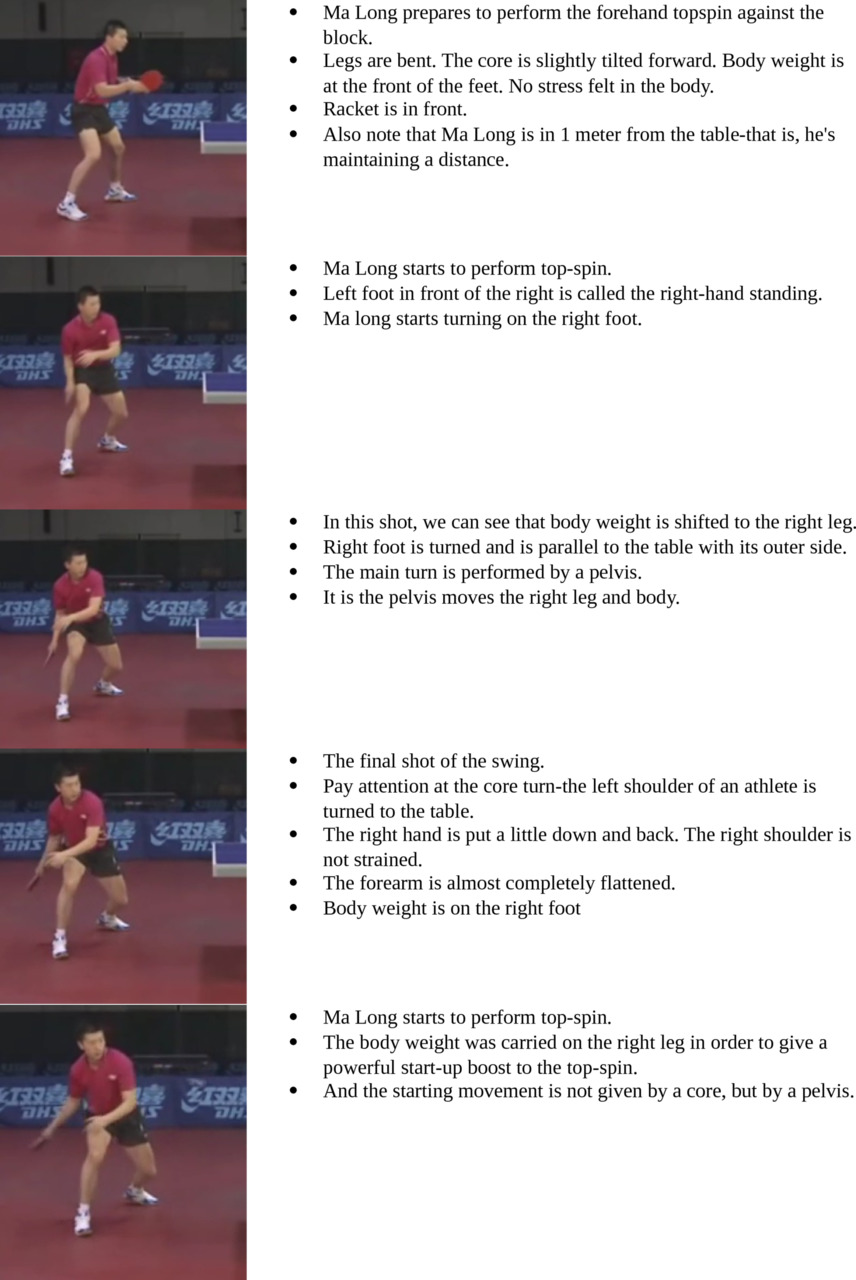
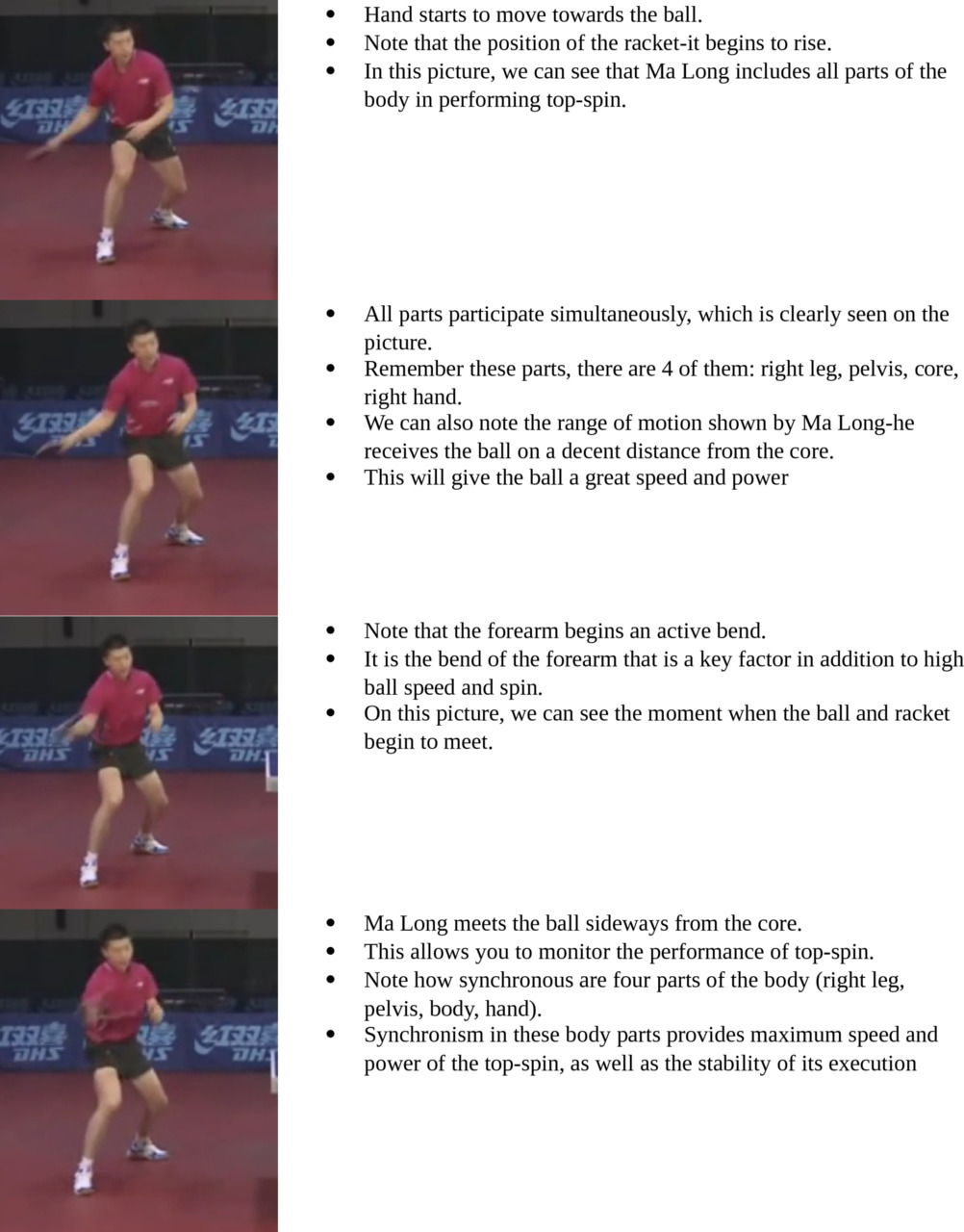
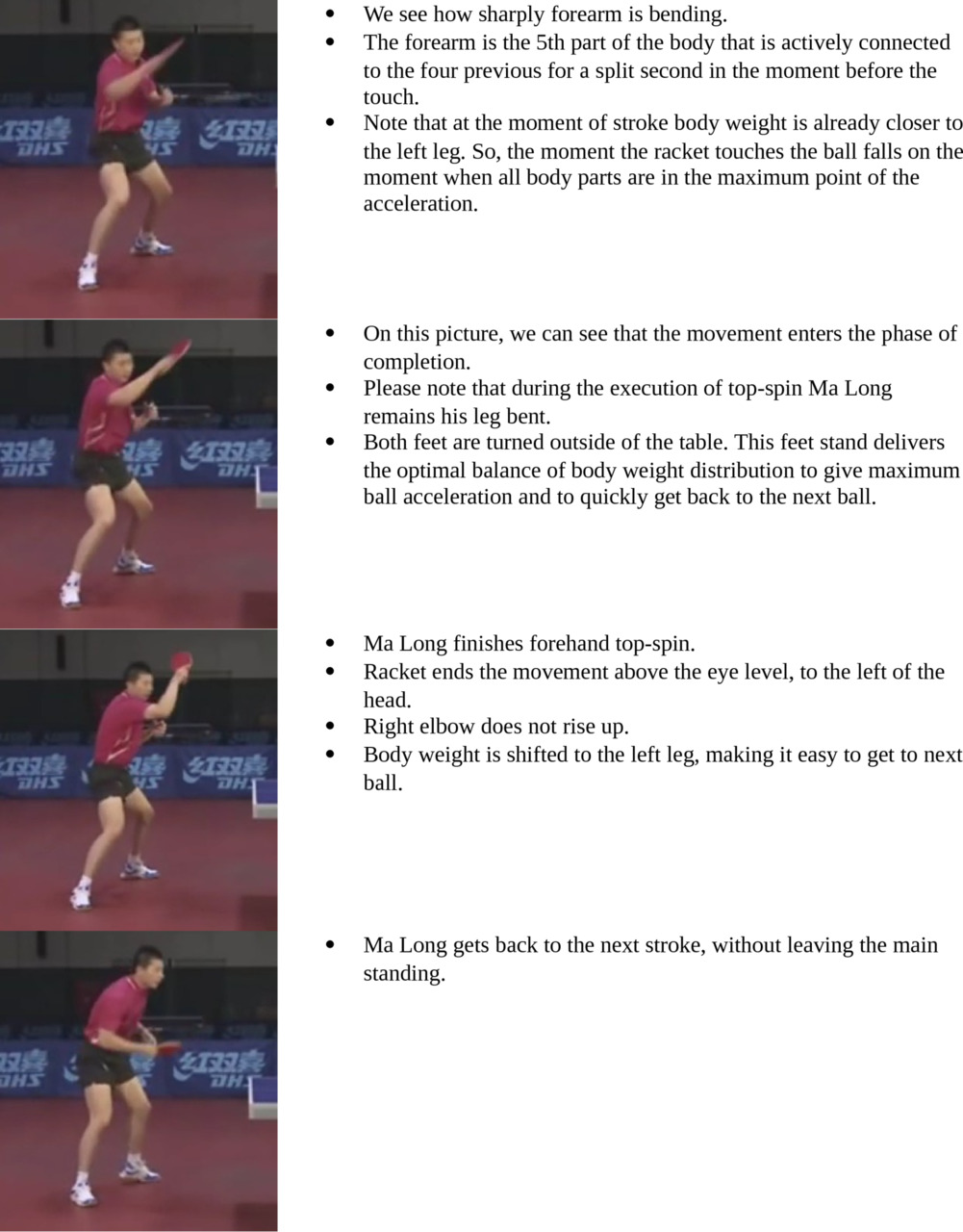
Variation #2. Powerful forehand top-spin
Powerful forehand top-spin is used to complete or intensify an attack. Of course, it is used much less often than the forehand top-spin against the block, since it requires such situation when its performing is possible and appropriate.
What is the situation? The interesting thing is that for each athlete there are “personal” suitable moments. One performs a powerful forehand top-spin only on balls, raised slightly higher than normally, and the other can perform it right after the first chopped top-spin. And someone generally has the ability and skill to perform top-spin to win points immediately after a serve. It all depends on the explosive qualities, ball sense, general abilities, habits and athletes game models.
Let’s now see the difference between the powerful forehand topspin and the “simple” forehand topspin against the block. It is different in three components:
— Legs position.
— Amplitude.
— The speed of racket passing through the ball.
Legs position at a powerful top-spin is much wider. This position provides great stability for the top-spin and provides the possibility to add a second component — amplitude.
The movement amplitude becomes greater. Moreover, the broader movement is performed by the arm, legs and pelvis. It all starts with a wider swing and ends with with a deeper finish. All this together, provides more kinetic energy and, consequently, more targeting for the ball flight.
The speed of racket passing through the ball is 1.5 — 2 times higher. Everything is clear here — the higher the speed of racket passing through the ball, the higher the speed of flight.
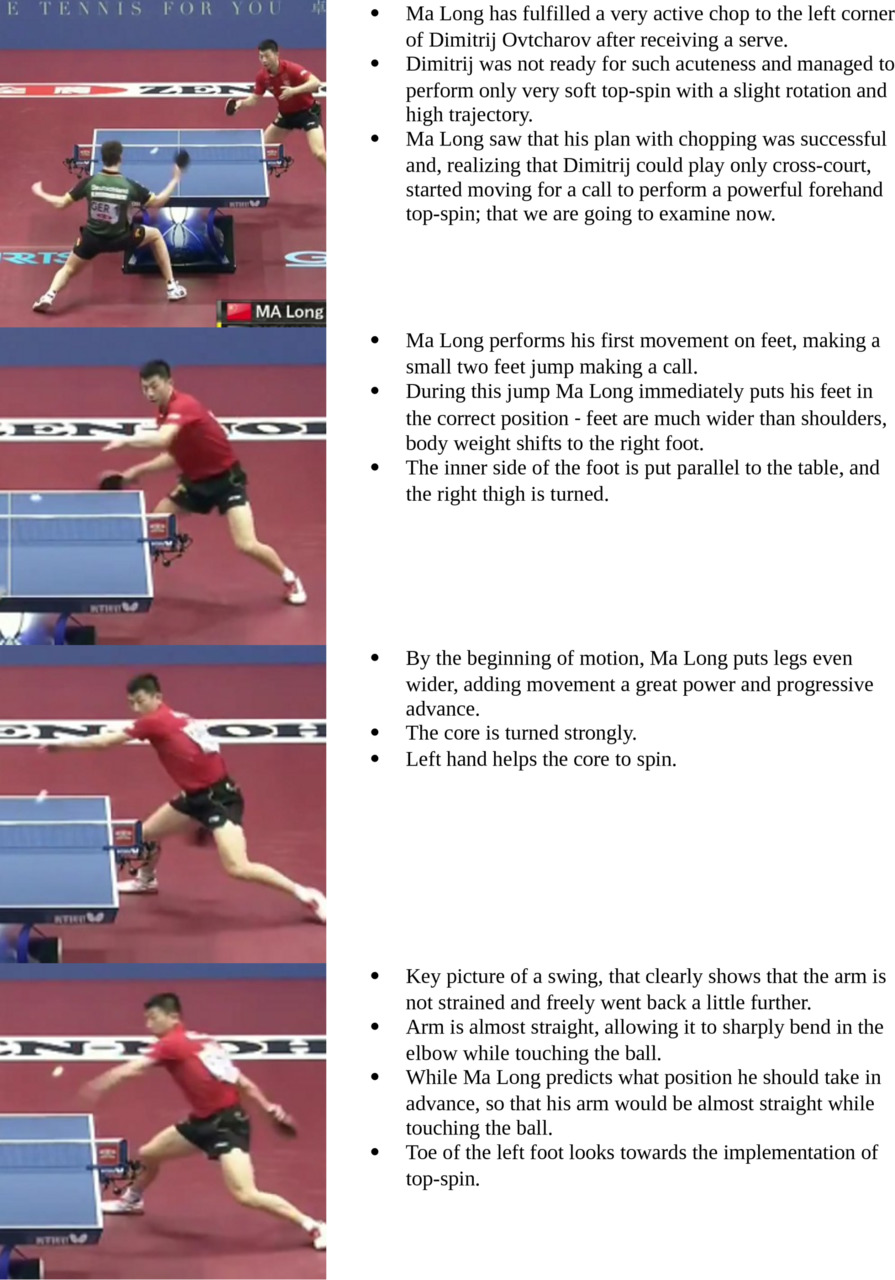
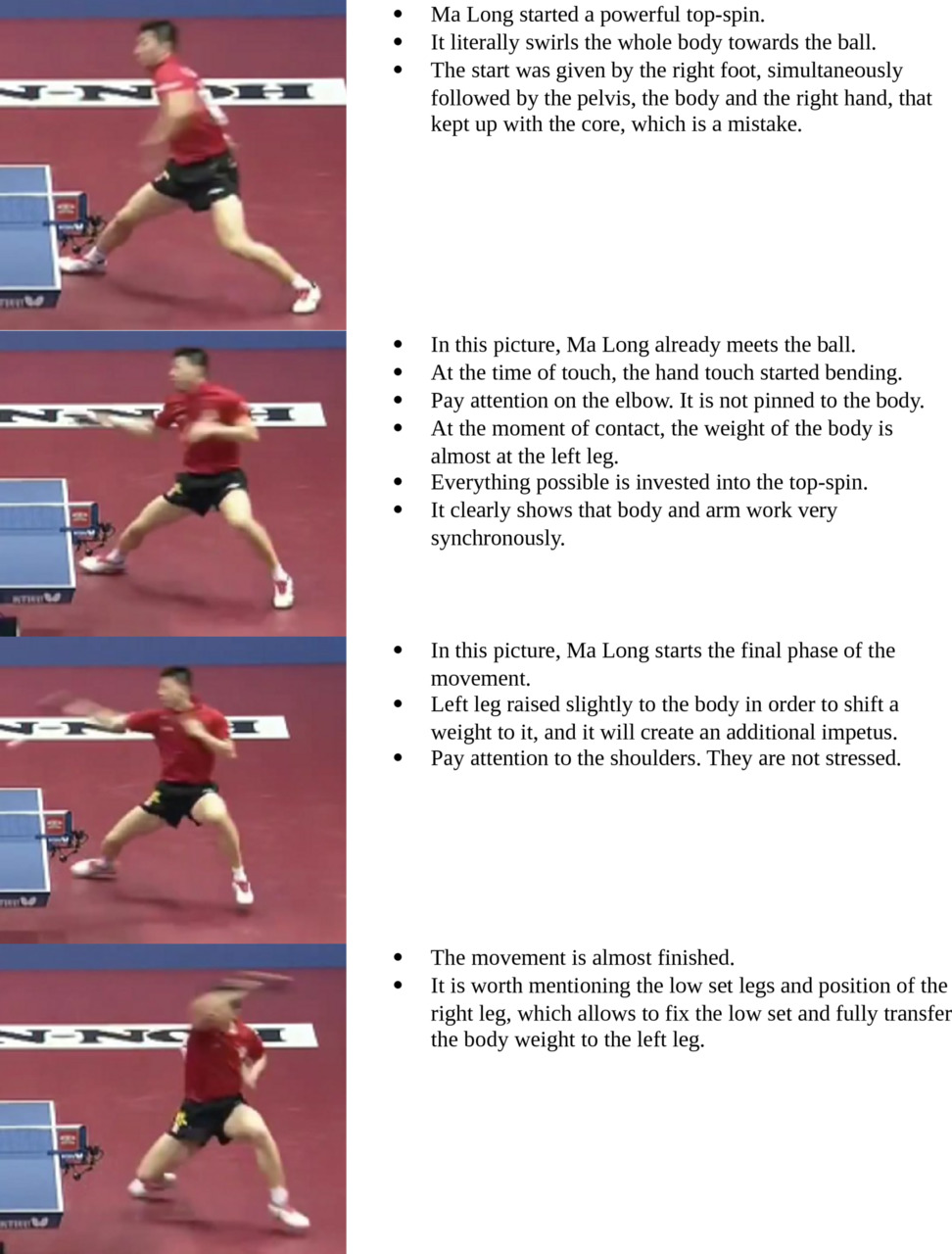
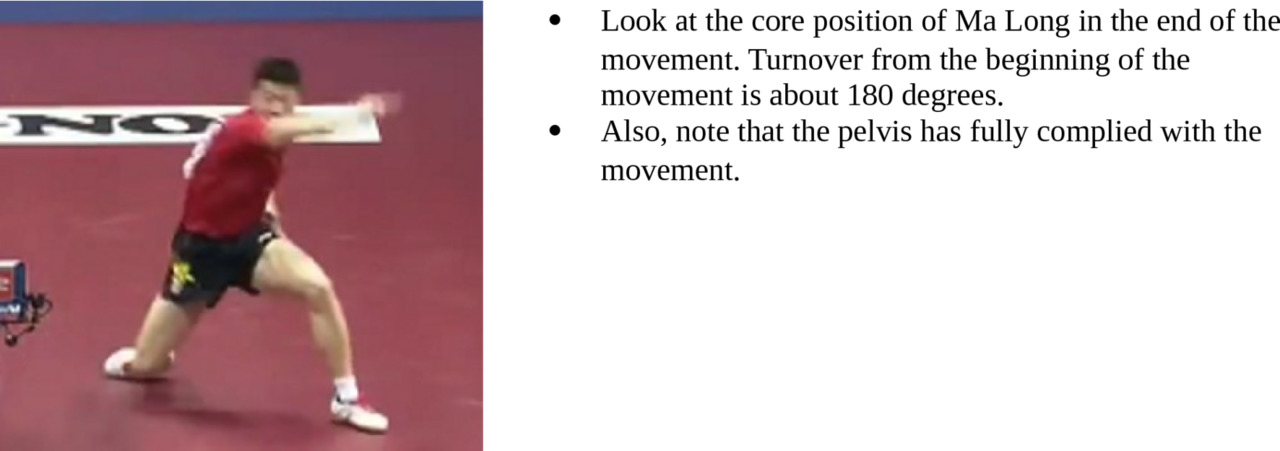
Once again we draw your attention to the simultaneous inclusion of the four parts of the body at the powerful forehand top-spin (right leg, pelvis, core, right hand), which is mentioned in the comments to the pictures, becomes the determining factor. At the slightest non-sync of these parts of the body a powerful forehand top-spin is impossible.
It should be noted that simultaneous inclusion of the four parts of the body is important in all variations of top-spin. Without exception. Well remember these parts:
— Right leg.
— Pelvis.
— Core.
— Right hand.
Variation #3. Chopped forehand top-spin
Chopped forehand top-spin is a variation that is learned after mastering the forehand topspin/loop against the block. It is learned as a second element because it is more difficult to perform.
Mastering of this variation is critical to the level of playing table tennis. Not owning this variation at all (or enough), it is impossible to achieve any result.
80% of attacks begins with this element in the table
tennis. Mastering (or not) this top-spin variation largely determines the ability of the athlete to play at some level.
Forehand chop is different from the forehand loop against the block by four main criteria:
— Swing.
— The movement width.
— Racket tilt.
— The direction of movement.
During the backswing, the racket is lowered much below to create a large amplitude of movement necessary to give the ball a good spin at the lower spin of the opponent.
And the hand with the racket not just falls below, this happens due to the right leg being more bent, a bigger turn of the pelvis and the greater extension of the arms at the elbow.
Together, all this provides a greater width of the movement, which is necessary to perform a complete chopped top-spin.
The movement is broader because at the top-spin from the block we are dealing with a ball that is spinning in a direction that is convenient for us. The speed of its flight contributes to our top-spin speed. Roughly speaking, the faster the ball flies off the block, the more speed our top-spin has. The whole block speed is converted during our top-spin.
With a chopped top-spin the ball spins in the other direction, and we need to cut off its rotation, and add its own rotation.
In other words, the chopped forehand top-spin requires significantly more effort than top-spin against the block. The wider movement is necessary to ensure this effort.
The tilt of the racket at the chopped top-spin is more open. Because if we play the ball with the same tilt of rackets, as in case of the top-spin against the block, the ball would get into a net with a great probability. It would lack enough trajectory to fly over the net. And trajectory reserve is attached to a ball due to a good rotation.
Movement direction at the chopped top-spin is different from top-spin against the block significantly due to the greater thrust up.
Here works the same principle as with the tilting of the racket. I.e. if you send motion too forward, the ball most likely would get into the net.
The end of the movement is also slightly higher. The higher the position of the racket is provided by the previous components: width and direction, more open racket tilt.
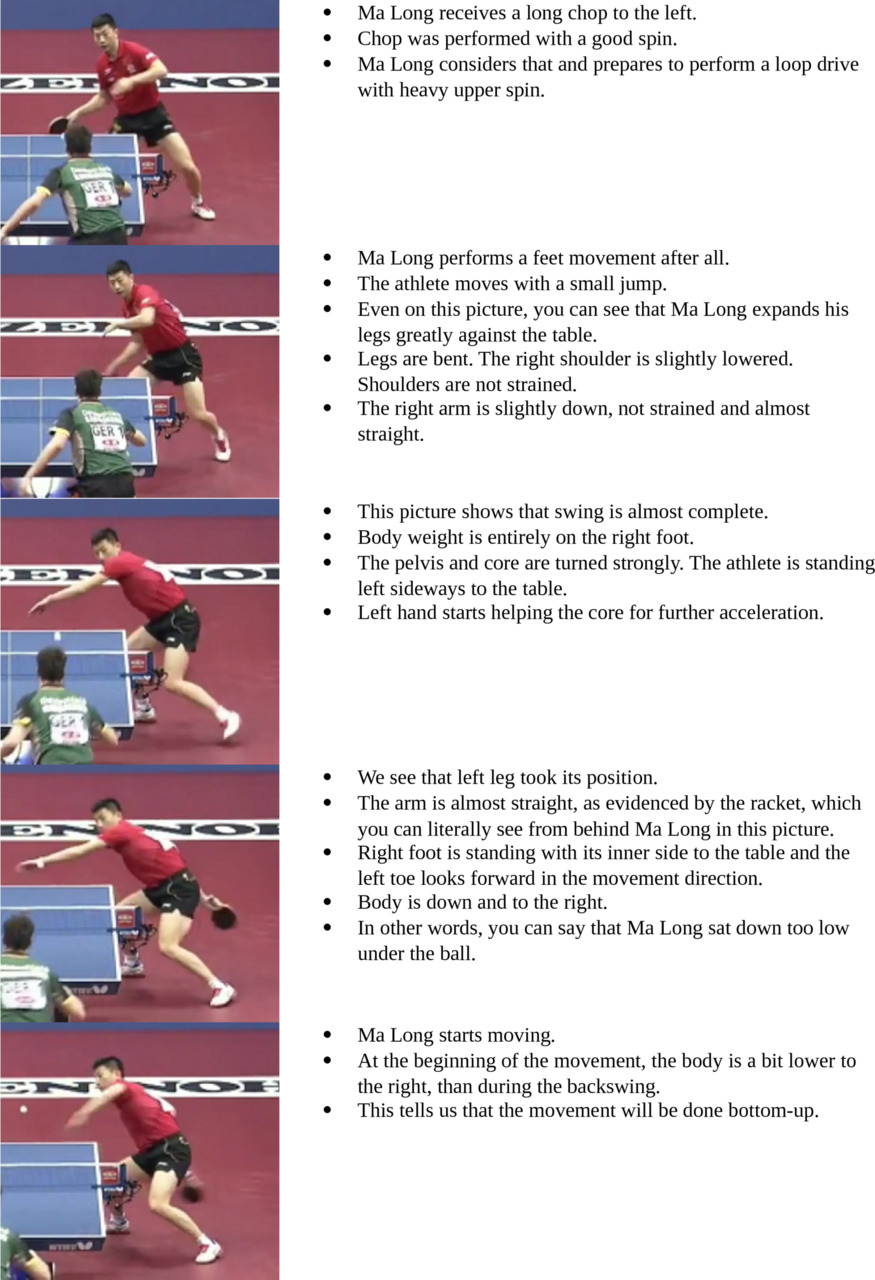
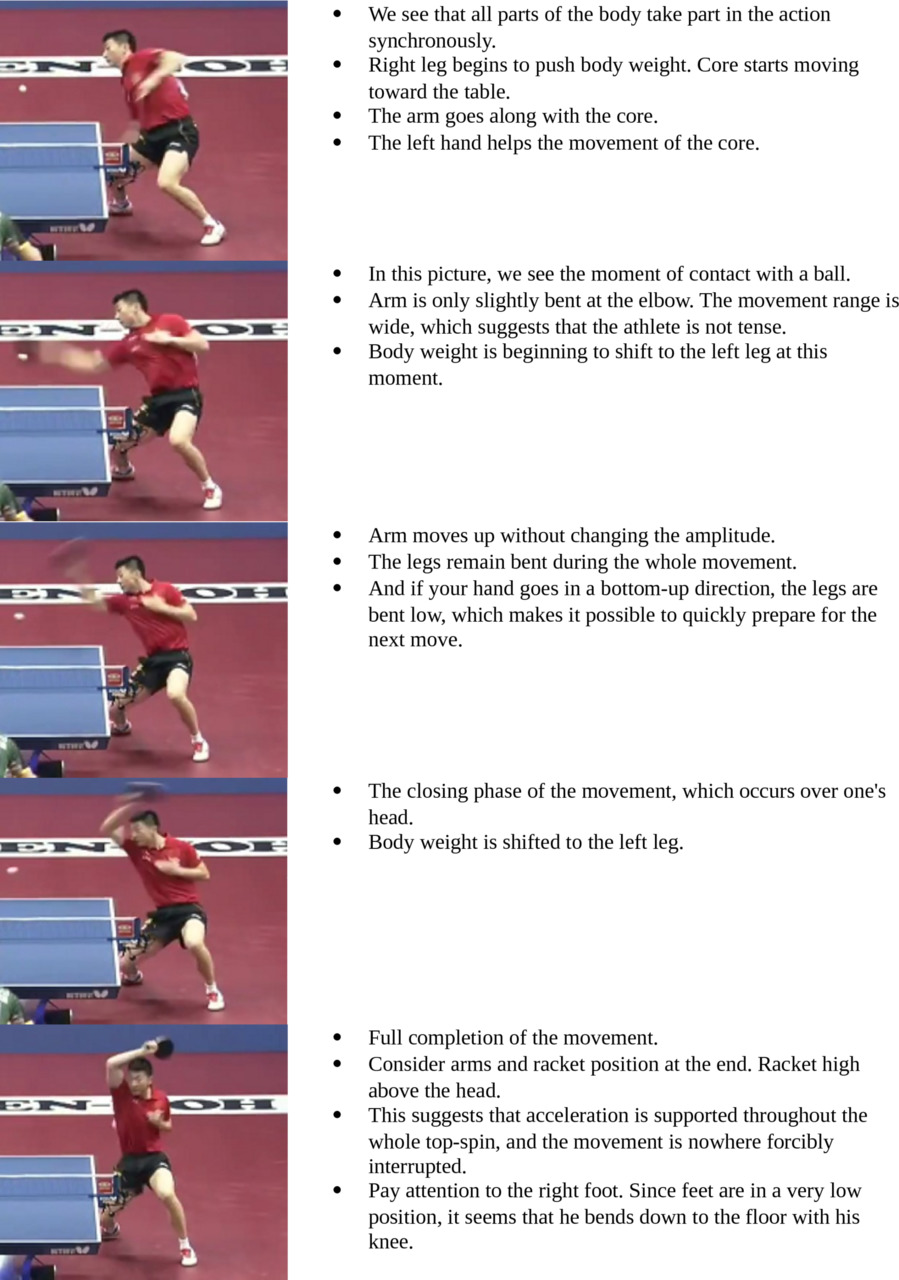
Variation #4. Counter-loop from the middle zone
Counter-loop from the middle zone is called “over-rotation” or “overspin” among the tennis players.
For example, if you hear an athlete says “won the point in overturn”, it means that there is a rally in a central zone when both opponents exchanged counter loops and he managed to win the point. In the future, we will designate this element as “overspin”.
So, the “overspin” occurs during matches not very often, because not all rallies end up with the setback to the middle zone of both athletes.
How does it happens that both athletes suddenly find themselves in the middle zone?
It all starts with the fact that one of the athletes begins to attacking, while the other seeks to not just play passively, but perform a counter-action. The most common counter-action in table tennis is counter-loop.
When one of the athletes starts to counterattack, he has to make a half step or a step back in order to have enough time for a counterattack. Counterattack — this element seizes ball’s speed and rotation and turns it back (making it a slightly powerful).
Therefore an athlete that has just performed a top-spin and received a counter-attack, has also to make a step back in order to have time to conduct his counterattack. And so with each following counter-loop athletes make a small step back as the ball is gaining a lot of airspeed and power. As a result, after one or two counter-loops athletes are already in the middle zone.
How the “overspin” differs from the top-spin against the block?
It differs with a slightly wider move,
because of the need to send the ball on a greater distance. The difference is in sending the ball to the opponent’s side from a distance of 1 meter or 2.5—4 meters, but the main difference is not the width of the movement, but also the time of handling the ball.
Ball handling should occur with a strong ball contact, meaning we should hold a ball on the racket for a longer time. As it’s expressed by the players — to sense it better. Longer contact with the ball is necessary to control the flight of the ball for a longer period of time and to be able to send the ball from a longer distance with the same accuracy as in the case of top-spin from the block.
“Overspins” in various zones are different by its performance. For example, there is a notable difference between “the overspin” from a distance of 2 meters from a table and the distance of 3.5 meters.
In the first case, the movement of a little shorter, ball handling occurs practically at the highest point of rebound and directed more forward. The power given to the ball by the opponent is clearly felt in the highest point. We fully return that power and speed back to the opponent.
In the second case, the ball begins to fall (that is, by this moment he had already passed the high point) and at this distance, the power of the ball given by the opponent is sensed much less. We have to add the ball more to spin and send the ball upwards to give it sufficient trajectory that will safely allow a ball to steer clear of a net and land on the opponent’s side.
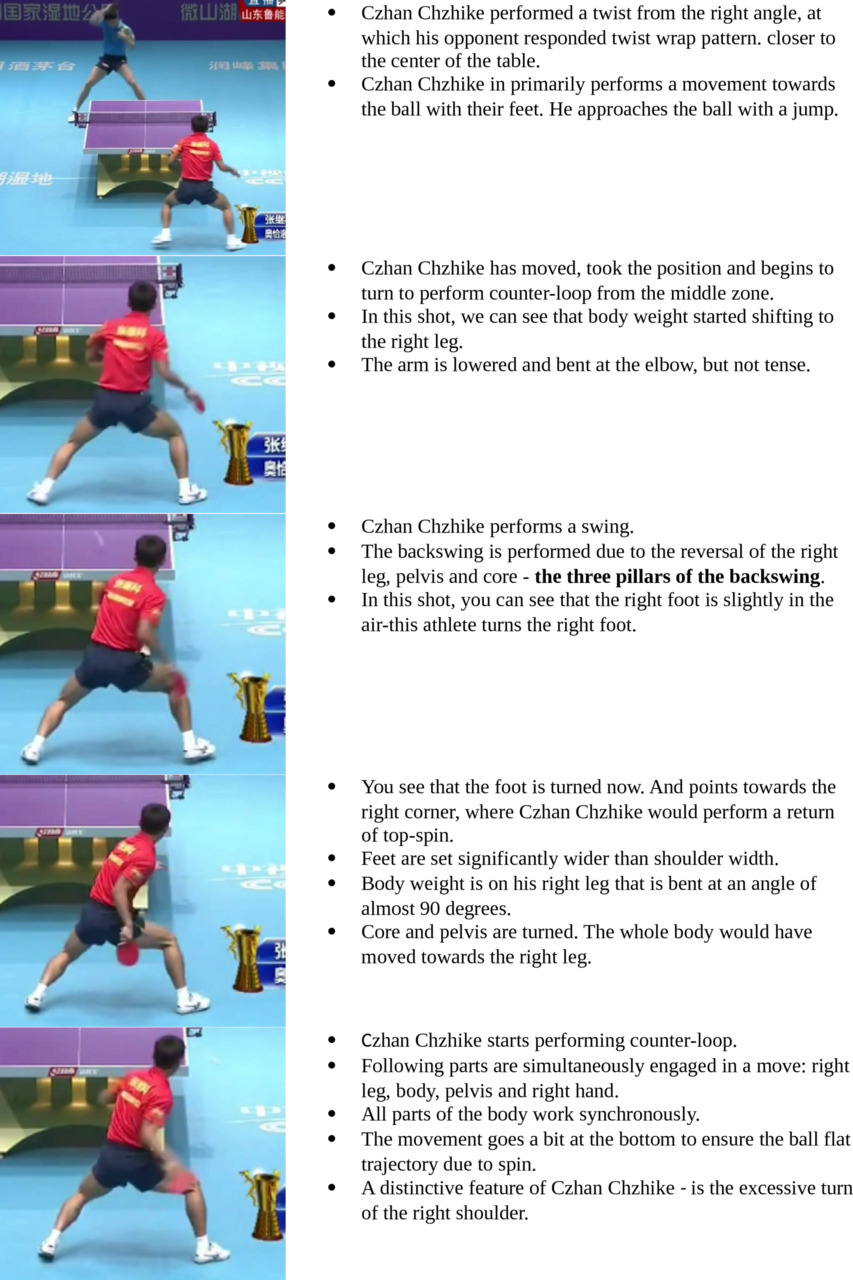
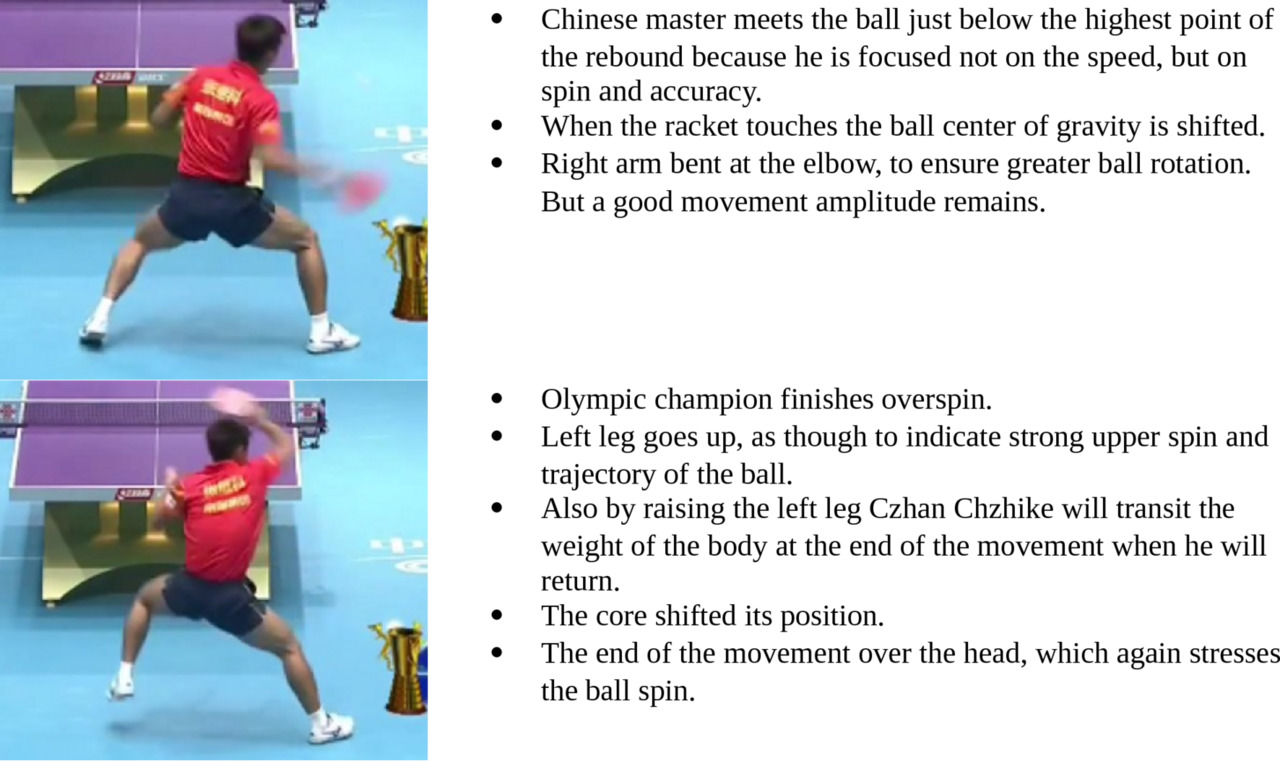
Variation #5. Counter-loop on the right side of the table (in the near zone)
The forehand counter-loop on the table is very different from all components of the forehand counter-loop from the middle zone. That is why we assign it to a separate variation.
This element is also called the “interception of an attack” “or “twisting”. By the way, the most interesting thing is that in some cases, it is more logical to say “tackle/interception” and in other, more appropriate would be the word “twisting”.
For example, when you perform a forehand counter-loop on the table by first attacking move of your opponent, it is better to call the counterattack as “interception”. As you would seize the initiative, which your opponent was trying to take over. And when a mutual counter-loop game began on the table, it is better to call it “twisting” or “twist against twist”.
Now let’s talk about the technical part of the counter-loop to the right on the table. The main difference of this element is that it is performed much earlier than the highest point of ball rebound, it is executed on the bottom-up ball, at the moment when the ball is only gaining height.
Also, this element is performed very close to the table. Closer than all other variations of top-spin, used in the rally.
Why do you need to play bottom-up ball closer to the table during this element?
The meaning of this element that you are also using speed and spin of the ball you receive, in other words, you do not add your power and spin, but use the one that was input by the opponent.
When performing this element, the inclination of the racket is slightly more closed than in the classic top-spin from the block. Especially it is necessary to draw attention to the fact that at the time of the racket passing through the ball, you don’t have to play it hard.
In table tennis, there are concepts — “game ball” and “the ball game”. Let’s study them.
“The ball game” is when maximum rotation is added to the ball due to the rubber grip, i.e. the blade does not mostly participate in such game. We can say that this is a more gentle, “sliding” ball handling.
The best example of the ball game is chop. If a tough clash occurred between racket and a ball, it is called a push, rather than a chop. Qualitative chop is when the lining “slips” along the ball, adding maximum rotation to it, but not adding any speed.
The same principle is used for interception. The rubber “slips” greatly on the ball and it does not receive an excessive rigidity.
“The game ball” is, as you guessed, the opposite of “ball game”. Here, by contrast, comes a tough game ball, rubber is forced under ball’s pressure and we actually feel the blade participating in the element.
The best example of a ball game is a final smash without rotation (which, incidentally, is very rarely used in pure form in today’s table tennis).
We have elaborated on the moment when racket passes through the ball because this point is critical when performing counter-loop on the table. Once you play the “ball” hard — your “interception” immediately flies over the table.
Few words about the movement itself. Correct swing is very important for performing the “interception” and “twisting”.
Since we use the speed and spin of the received ball standing close to the table, when implementing this element, we need a much shorter backswing. The hand starts its movement, not going below the table level. It stays bent at the elbow.
Legs and pelvis also do not go down and sideways, the athlete‘s position is neutral. The core is turned a little bit when performing backswing.
While performing this element the slope of the bat is slightly more closed compared to the basic version of the forehand topspin against the block.
Let’s dwell on the moment of passing the racket through the ball. As mentioned above, the racquet “slips the ball” more than “strokes” it. But the speed of the racket passing through the ball is also important here. The racket should be ahead of the ball, of course, in fact, it’s impossible, but you must support this desire. If you will try to get ahead of the ball in the moment of touching between the racket and the ball, the ball will lie on a table. But if the racket would pass through the ball with the lack of speed, the ball flies off the table because you do not have time to block the rotation that you receive.
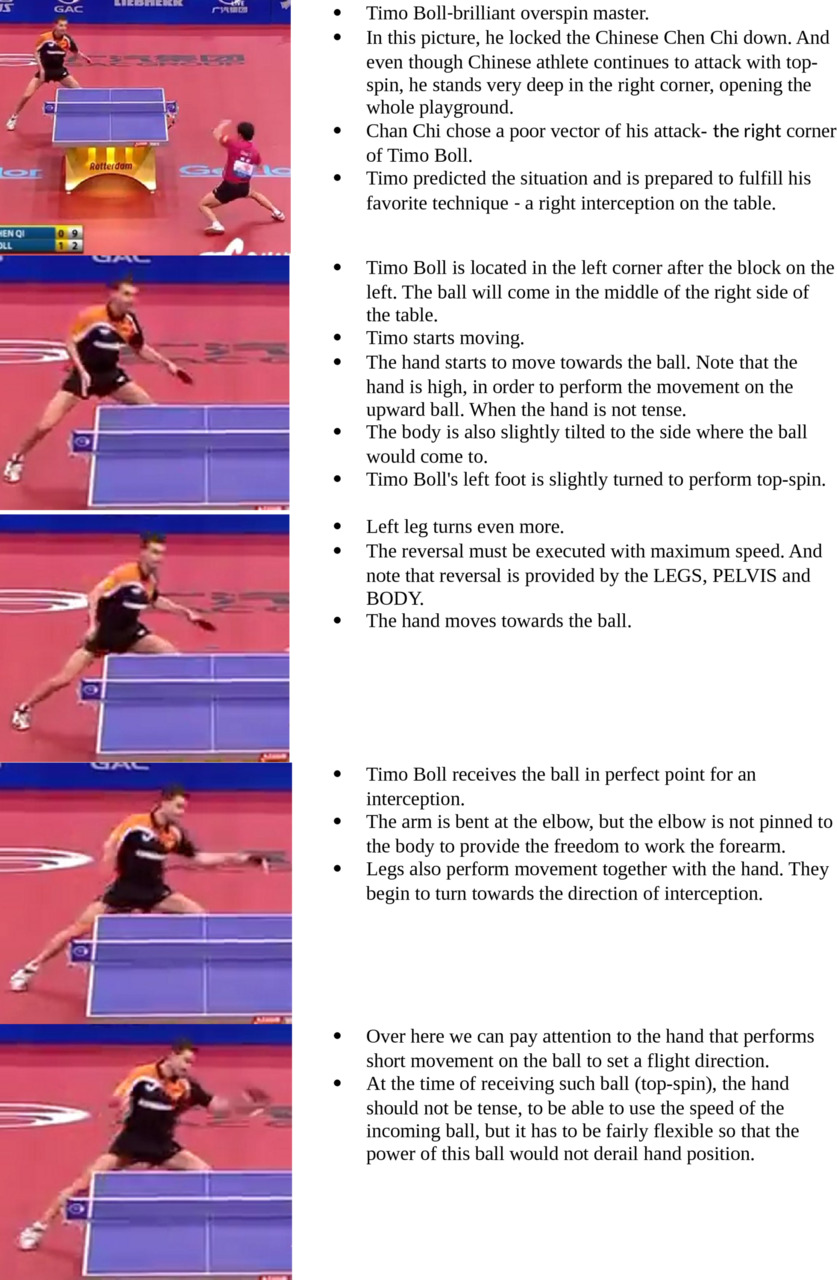
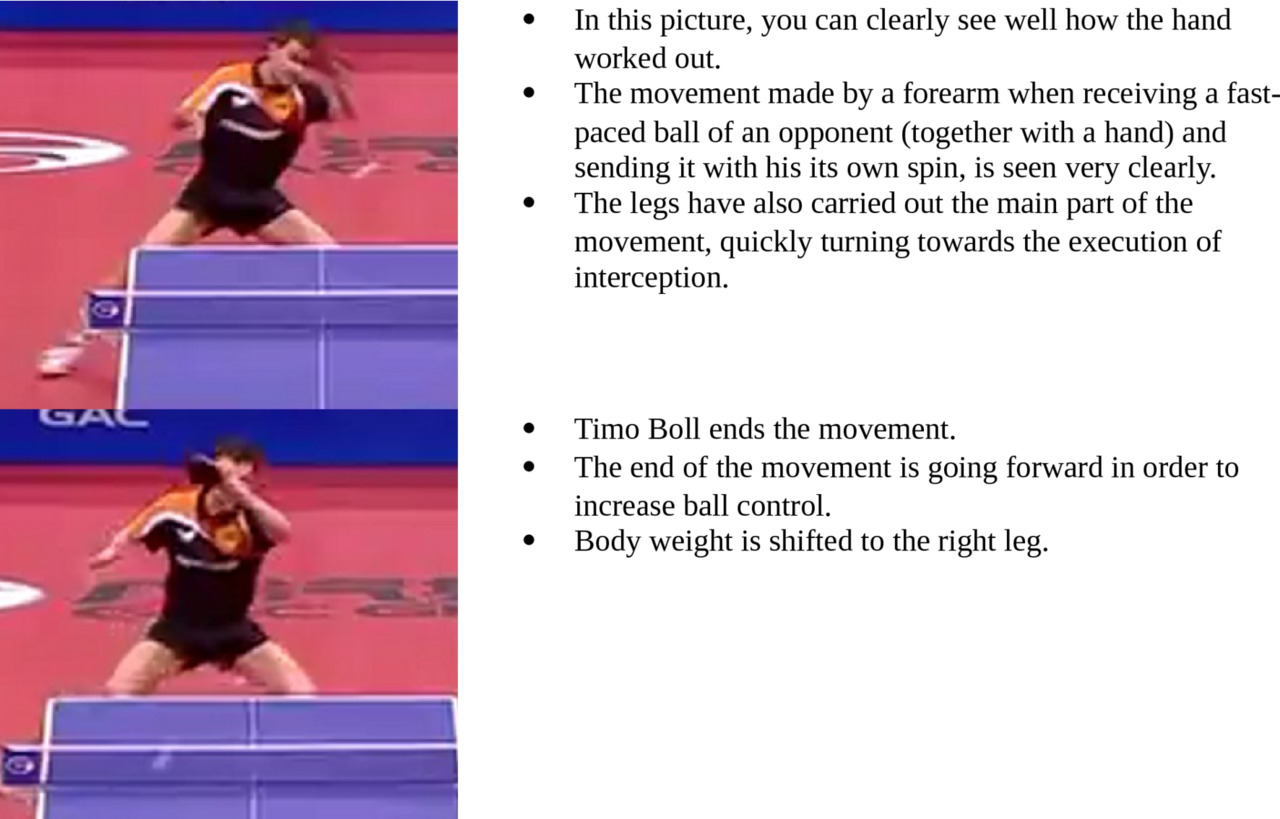
Variation #6. Forehand top-spin on the outflying ball
We turn now to a rather complex and unusual variation, unusual among the people playing at an Amateur level. The fact of the matter is that there is a number of variations, which are studied only after reaching a certain level in table tennis — it does not mean that these variations are much more difficult to accomplish. No. That just means that without mastering these variations it’s hard to progress further at a more serious level. And at the same time, it is hardly known about such variations at a lower level of mastering this technique.
If you master variation No. 6, you get a significant advantage among your fellow athletes. And they most likely will not even understand what is going on and how you manage to do this.
Imagine that you are receiving a simple bottom spin serve. The ball strikes your side for the first time and then flies out the table, but not too far, just 10 cm. And if you didn’t know in advance that this serve would fly 10 cm off the back edge of the table, you would have thought that this serve is short, isn’t it?
That’s exactly the kind of ball called “flying a little out” (sometimes referred to as simply flying out or “thin”). By the way, in English, this ball has a more creative name half-long ball that literally can be translated as a semi-long ball. This is the only English term for such ball; but in Russian, there is no clear term for this ball. Most coaches and athletes call it differently.
What is the difference between the forehand top-spin on such a ball from usual chopped top-spin?
The fact of the matter is that such ball uncomfortable to approach on legs. If you’d try to apply top-spin to this ball with
exactly the same movement as for chop, then it won’t work. Your legs will not be able to take such a position where the ball, that is out for 10 cm, will be exactly in the same position relative to the body, as in case of chopped top-spin.
You may have guessed, why isn’t it possible to approach such ball with the same convenience as in case of chop. The secret is that the table would hinder you to put the left foot properly. Or you can stay in the position in which you are performing the chopped top-spin, but in this case, the ball will be strongly ahead of your body that won’t allow you to process it and add a spin to it.
How is it then possible to perform forehand top-spin this ball?
The main nuance of top-spin performance on such a ball is the position of your legs. If at the ordinary chopped top-spin we put our left foot a little bit ahead of the right one, in this case, it is completely the opposite. We do a half-step forward with your right foot and only then perform top-spin.
When you do this, note the following techniques: If we include the motion of legs and pelvis during the chopped top-spin, then when performing top-spin on the outflying ball all the basic work is done by the forearm and hand. We think you understand that making a step forward with right foot, you lose the possibility of a full-fledged movement, but it is not necessary in case of this element.
The fact of the matter is that the ball, which flew out on 10 cm over the back edge, does not have such a strong spin, as in case of long chop. Plus the distance to which we should send this ball is reduced almost to a meter, which makes the task easier for us.
In the end, we just need to give this ball a strong rotation, without large power, i.e. not making a move forward.
Do you remember when we discussed the previous variation, we talked about such concepts as “the ball game” and “the game ball”? When performing a top-spin on the outflying ball these concepts are also relevant.
When performing top-spin on the outflying ball, we have to play exactly “to the ball”, without exerting any pressure on it, because we need to send the ball to the table at a higher trajectory. After all, the ball flew just 10 cm out, and if we play it hard, the ball would lack a trajectory reserve to fly over the net. That is why we need a good spin that is provided by the “game ball”. That is, the performance of this element also involves rubber and minimum use of the blade.
The similarity of top-spin on the outflying ball with the previous variation only in this component. The movement itself is directed upwards here. The tilt of the racket is the same as with the chopped top-spin.
As already mentioned, the main work is done by the forearm and the hand at this top-spin. Therefore arm is unbent at the elbow, and then performs an upward movement. The hand also helps the forearm as much as possible to handle the ball.
Let’s go back to the feet standing. We expose the right foot forward sitting down as low as possible. At this point, the right leg is heavily loaded and bent at an angle of 90 degrees.
We also lower the body. We can say that we are “folding” to perform this top-spin.
Another important point is the end of the movement.
If in case of classic top-spin from the block and chopped top-spin we finish the movement in the forehead area, here the move is stopped earlier. You will not be able to complete the movement. This was not supported by the initial position and the overall motion path.
Now a few words about how to use this top-spin in the game. It is used to launch the attack and seize the initiative in a situation when there was a minimum opportunity for this.
Do you remember at the beginning of the description of the variations we told that it’s being studied at a higher professional level (or it is learned by young athletes who have all reasons to pursue this level). And for good reason, since it is only at this level it becomes critical to start an attack with the ball barely flew behind the rear edge of the table. At a high level, if an athlete misses (doesn’t see) such a ball, there’s a 90% possibility he’ll play it long enough so that the opponent would start his own attack.
That is, if you have missed your chance at the beginning of the attack, your opponent will seize this chance. And at a high level, the initiative possession means a lot, and it is highly undesired to ignore the outflying balls.
At the amateur level, this is nothing to worry about, because there is often no such desperate struggle for the beginning of the attack. If you master the forehand top-spin to the outflying ball, you get a huge advantage.
Top-spin on half-long balls can be used to receive the serve of an opponent, when it is a little bit longer and simply with any flying out balls that are in the game.
Let’s look at another point worth emphasizing. Many athletes, performing such top-spin, try to win points due to them and it is the fundamentally wrong approach.
As we found out, top-spin on the half-long ball is performed with the maximum number of spin that is, it has no power. And it is not necessary. It performs a preparatory function for us. Performing this top-spin in the form of strong rotation, we put the opponent in a difficult position.
Let’s consider options of receiving such ball. Under the option, that the opponent will try to aggressively counter-attack, considering the fact that the ball is not too fast and has a higher trajectory and we performed top-spin, taking into account the recommendations, giving it maximum rotation, the chance of opponent’s successful counter-attack is reduced to 20—30%. If our top-spin has a little rotation, then the probability of opponent’s successful counterattacks is 60—70%. Erring once, or better, twice, in carrying out counter-attacks an opponent will just start driving this ball, and we will have an excellent opportunity to continue the attack and win points.
That’s what the forehand top-spin on a half-long ball is used for. The purpose of its use — to seize the initiative, put your opponent in an uncomfortable situation and prepare for the opportunity to continue the attack and win points.
Another aspect that we cannot ignore.
The attentive reader noted that when the forehand topspin (loop) is performed on the flying ball from the right-hand corner, the left leg, of course, hinders. And what about the left corner? We can safely bet your foot over the corner of the table, and nothing would interfere us.
And the reader will be right. Much of what we now discuss (in addition to tactical points), refers specifically to the forehand top-spin on the half-long ball from the right side of the table.
When playing from the left side there is really nothing hinders us and we can take a full position, placing a left foot forward, but the tilt and the passage of the racket through the ball remain the same. It is also important to play “the ball”, adding it a good spin. And similarly, the main share of the work is performed by the forearm and hand, and the movement ends slightly earlier.
These technical issues remain the same because we are talking about a ball that flew only 10 cm out and we must not try to play it immediately. We need to prepare ourselves, playing the ball safely and with good rotation.
Incidentally, it is much easier for children to play such balls than for adults, because they are not hindered by a table and due to a small stature, they can safely put the left leg under the table and perform a full top-spin to the outflying ball.
Still, we recommend coaches to teach kids to play with this ball technically correct because it is always difficult to relearn. It is much easier to instantly learn the correct execution.
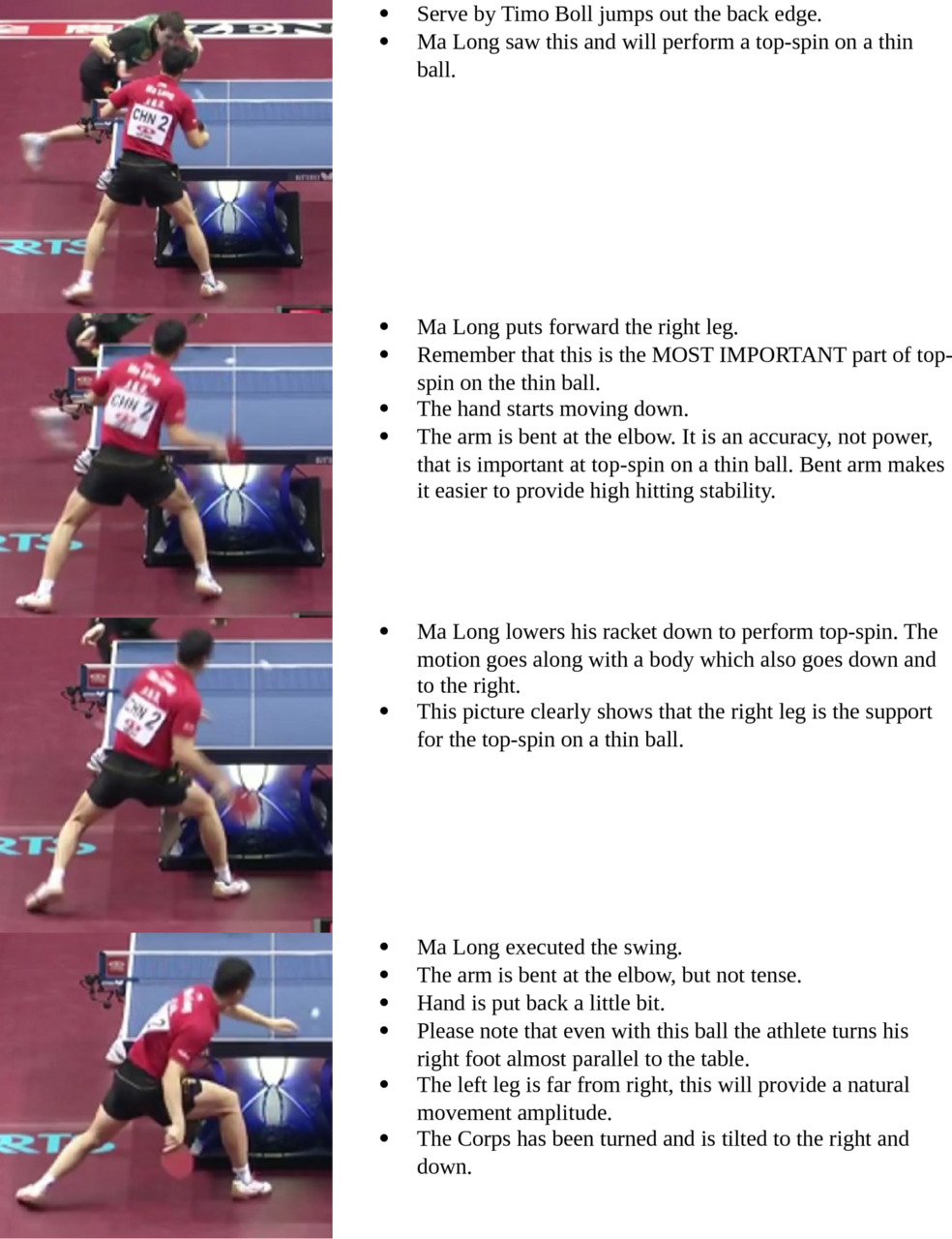
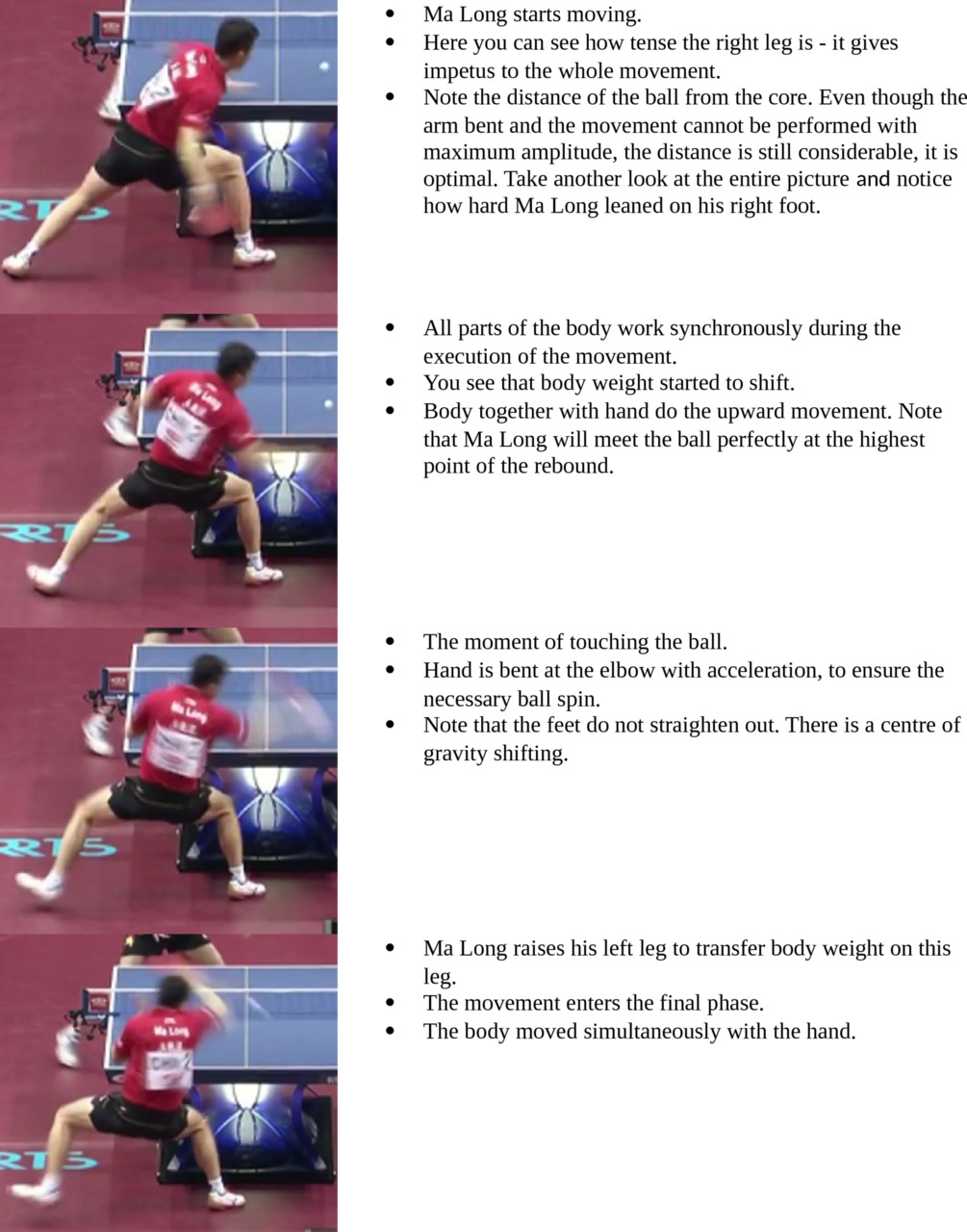
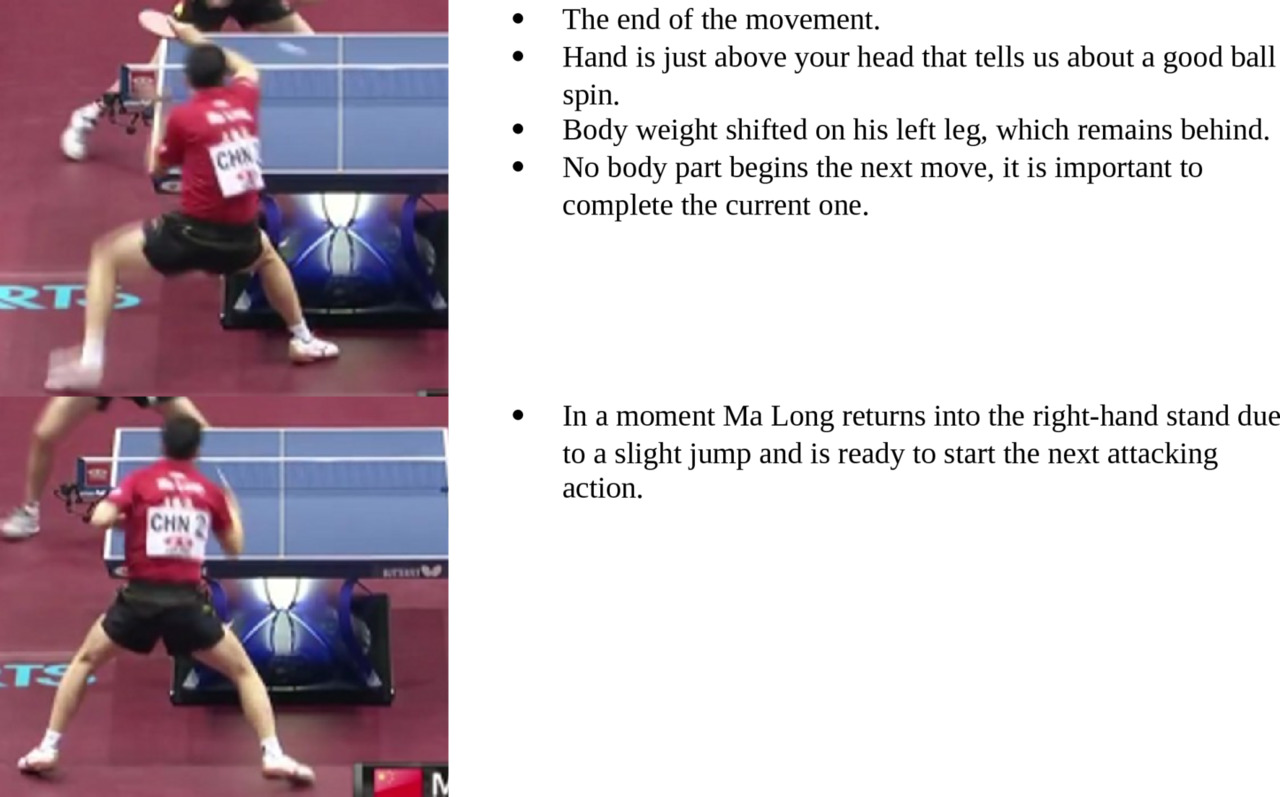
Variation #7. Forehand top-spin on the uprated ball
In the game, there are often balls that are very easy for winning points.
For example, you made a short serve with a side top-spin, your opponent didn’t notice that, he performed a chop and the ball turned out very high, you might even say, perfect to complete the attack.
However, oddly enough, many athletes make a lot of mistakes when playing such balls. Let’s try to understand why.
Бесплатный фрагмент закончился.
Купите книгу, чтобы продолжить чтение.
